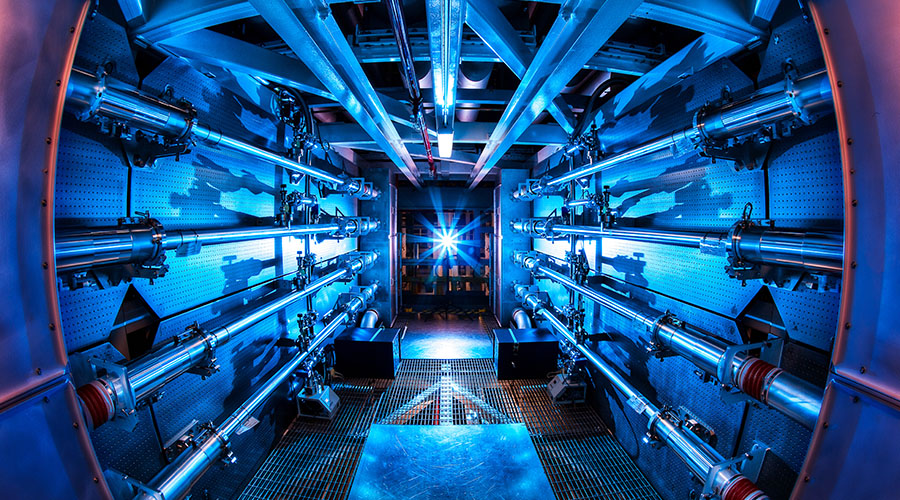By the FYI Team | February 16, 2023

Credit: Lawrence Livermore National Laboratory
Preamplifiers of the National Ignition Facility at Lawrence Livermore National Lab, which achieved fusion “ignition” in December 2022. Large-scale fusion faces enormous hurdles.
In the last two years, lawmakers passed landmark legislation that couples new support for research and development (R&D) with big ambitions for industrial growth, including the CHIPS and Science Act, Infrastructure Investment and Jobs Act, and Inflation Reduction Act. The Biden administration now seeks to swiftly implement the bills, which provide billions in direct funding for new initiatives.
However, most federal science programs still depend on annual appropriations and could face headwinds this year in a divided Congress. But even with partisan gridlock, 2023 is poised to be another busy year for science policy. Here are five stories to watch in the months ahead.
Test begins for Biden-era industrial policy
The Biden administration will face challenges as it begins implementing the new R&D programs and technology deployment incentives approved by the previous Congress. These include building up capacity within the Departments of Energy (DOE) and Commerce to administer funding and oversee projects. The initiatives will test the possibilities of industrial policy, in which the government actively steers technology development to promote economic transformation. Primed by the promise of federal subsidies, many companies have announced follow-on investments that the Biden administration now hopes to build on by fostering new “ecosystems” that better connect R&D with manufacturing, and that supply companies with financing, tools, materials, and workers. While some of this funding received bipartisan backing, Republicans have said they will closely watch these initiatives for signs of failure.
Divided Congress sets up rough road for science funding
With Republicans holding a narrow House majority, the party’s far-right flank is pushing for steep cuts in federal spending, setting up high-stakes standoffs with the Democrat-controlled Senate — including over raising the statutory debt limit by this summer and passing spending bills for fiscal year 2024, which starts Oct. 1. Science agencies would be hit indirectly by the economic fallout of a debt default and directly if Congress does not pass new appropriations bills, adding to current strains from inflation and supply-chain disruptions. Congress likely faces an uphill climb to meet the science budget targets in the CHIPS and Science Act, which largely includes only direct funding for semiconductor initiatives. The Biden administration may also need to rein in its ambitions for the National Science Foundation (NSF) and the Commerce Department, where other CHIPS Act initiatives were planned.
Particle physicists plot new directions for the field
U.S. particle physicists will chart a course for the next decade and beyond in a report, due this fall, from the Particle Physics Project Prioritization Panel (P5). Like the last P5 study, released in 2014, the report will propose a budget-constrained agenda for federal agencies, drawing on input gathered from the research community at last summer’s “Snowmass” conference. A recent summary report from the conference affirms the five science priorities identified by the last P5, while recommending a new focus on precision measurements of rare processes. It also proposes the U.S. prepare to “participate in or build” an electron-positron “Higgs factory,” a subsequent high-energy muon or hadron collider, and a next-generation gravitational wave observatory.
Fusion faces opportunities and setbacks
Lawrence Livermore National Laboratory’s recent achievement of fusion ignition stoked public interest in the potential for fusion power plants, though lab leaders cautioned that the prospect remains distant. Magnetic confinement fusion could offer a shorter path to commercial fusion energy than Livermore’s laser-driven method, and private fusion companies have raised billions of dollars in recent years, hoping to bring a magnetic fusion power plant online as early as the 2030s. The Biden administration is betting on it, launching a milestone-based development program to support the industry. However, the world’s largest magnetic confinement experiment under construction, ITER, recently discovered major manufacturing flaws that may delay the project by years, on top of a separate three-year delay expected because of the pandemic and supply-chain issues.
Equity push unfolds across science agencies
The Biden administration is also ramping up efforts to promote equity and inclusion in STEM fields. The DOE Office of Science’s new RENEW and FAIR programs will support workforce training and build research capability at institutions that have been historically underrepresented in the office’s portfolio. Federal agencies are also reworking their grant review processes to better incorporate equity. For example, the DOE Office of Science now requires grant applications to describe how they plan to promote inclusion in their research projects, and the NSF is reviewing the “broader impacts” criterion it has long used when reviewing proposals. Published by the American Institute of Physics since 1989, FYI is a trusted source of science policy news.
©1995 - 2024, AMERICAN PHYSICAL SOCIETY
APS encourages the redistribution of the materials included in this newspaper provided that attribution to the source is noted and the materials are not truncated or changed.
Editor: Taryn MacKinney
March 2023 (Volume 32, Number 3)
Articles in this Issue

